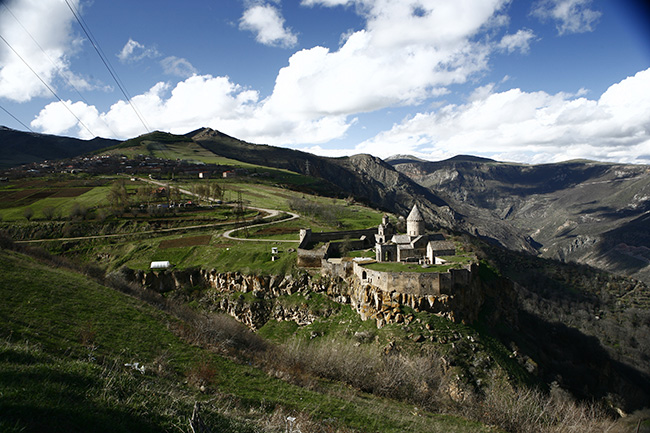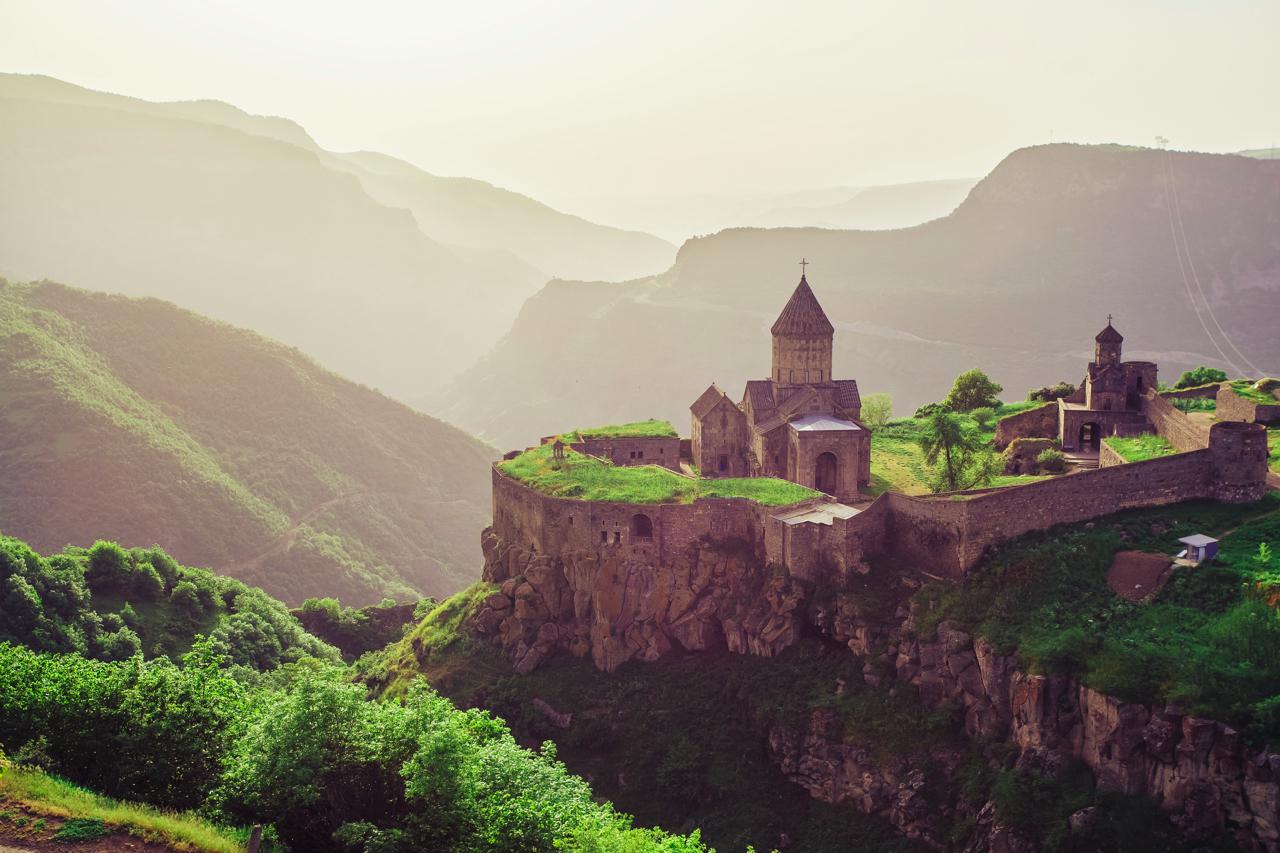
From the time of the Persian empire to the Soviet era, Armenia’s history has been one of conquest and renewal. Today this fascinating tradition combined with an influx of new development is luring travellers to the country’s capital, as Beena Nadeem discovers.

From the time of the Persian empire to the Soviet era, Armenia’s history has been one of conquest and renewal. Today this fascinating tradition combined with an influx of new development is luring travellers to the country’s capital, as Beena Nadeem discovers.
Wrought iron verandahs curl like tendrils. Café tables spill onto wide boulevards. Come dusk, illuminated fountains tango to the night call of music inside a square hugged by pink-hued buildings carved from volcanic rock. Walk a few minutes in any direction and you’ll find Soviet-era architecture: austere, functional high-rises that line bustling roads. Their brutally utilitarian presence is softened by grass as they clamber up the city’s hills, past the famed brandy factory (known for its cognac that once tickled the palate of Winston Churchill) and on towards the fabled Mount Ararat: said to be the final resting place for Noah’s Ark.
Yerevan, the 13th capital of Armenia, has a crooked beauty, though, like any mature lady – the city is 2,799 years old – we can forgive her a few wrinkles. Landlocked between Turkey, Georgia, Iran and its nemesis, Azerbaijan, the country has been a battleground for Muslims and Christians for centuries. Dominated by the Turks during World War I, it suffered the brutal mass slaying of 1.5 million Armenians under Ottoman rule. To understand more, Yerevan’s Armenian Genocide Museum, set in the crook of the Hrazdan River, provides an indelible insight into this pogrom. The country’s troubled history, along with the fact it only gained its independence from the Soviet Union 26 years ago, has seen its landmass shrink in size over the years, and it’s now about one-third the size of Tasmania.
The last decade has seen a rapid change in Yerevan thanks to investments from its wealthy diaspora, enabling the city to open its arms to well-heeled travellers. In 2007, the three-storied, honey-hued buildings of the newly created Northern Avenue opened to reveal five-star hotels and wallet-slimming stores in the ilk of Burberry and Armani. Meanwhile, a new cable car whisks you to Yerevan’s mountains where, among the verdant hills and ninth century monastery of Tatev, Armenia’s time stands still.
Getting around Yerevan is easy, manageable and safe. And although taxis cost just a few dollars, and chauffeured cars and even private helicopter tours are simple to organise, the best way to explore this city is on foot.
Walking around the city’s tangle of streets and parks, which drip with flowers, and the buzzing cafes, I pass the Italianate opera house where well-dressed crowds head for the ballet. Instead, I make my way to the busy intersection of Mashtots Ave and Sarmen Street en route to the city’s only mosque. Diving into a rather innocuous looking bookshop, I’m awed to find intricately carved shelves and ornate armchairs, overlooked by a gilded roof dotted with moss- and ochre-hued tiles.
A few minutes on, huddled among mid-rise houses and painted murals, is the beautifully tiled façade of Armenia’s 18th century Blue Mosque, where its tranquil gardens offer an oasis of calm from the frantic traffic outside.
Perhaps Yerevan’s best-known spot, however, is the centrally located Republic Square, where the more successful examples of Russian architecture reside. Here, neo-classical government buildings, crafted from volcanic pink-hued tuff stone, boast colonnades and majestically arched windows. By night, crowds gather to watch the fountains choreographed with lights and music.
At one point, a statue of Lenin glared from the square’s southwest corner. In 1991, it was unceremoniously pulled down and added to the courtyard of the Museum of Armenia, where it still remains.
Statue aside, the museum is worth a visit. A tour takes in everything from the world’s oldest shoe – 5,500 years old and still threaded with laces – to fully preserved wooden burial chariots and a row of giant phallus stones, some measuring three metres high.
The square is also home to the opulent Marriott Hotel, which comes with five restaurants, a spa, outdoor and indoor pools, and a knowledgeable concierge team.
By evening, I’m ready to take on Yerevan’s nightlife. I manage to avoid clubs playing raucous Russian pop and happily skip the Beatles tribute bar, and find the more sedate The Club, just a short amble from the opera house. Housed in a stone-walled restaurant, the space is also home to a bar, tea shop and underground bookshop where you can enjoy a few beers while sinking into cloud-like floor cushions. Malkhas Jazz Club is also popular, though I give it a miss as bed is a more favourable prospect.
The next day, an amble along Northern Avenue takes me straight to restaurant Tsirani. I devour plates of herbaceous salads, bread baked on site, olives, vine-ripened tomatoes, platters of soft cheeses, dolmas and grilled meats. I suddenly realise, with my girth expanding, that this is the first course. The main is stuffed trout – which makes two of us.
The most arresting part of the city is the Cascade. A giant white staircase carved into the green hills, it links downtown Yerevan with its upper neighbourhoods, with parts connecting to the Cafesjian Center for the Arts. I watch crimson-hued tourists puffng for air as they clamber up the stairs – I then take the escalator. On the way up are fountains, works of art and gardens manicured with scissor-like precision. From the top, I’m rewarded with unbroken views of downtown Yerevan, unrolled across the backdrop of Mount Ararat. Although I would love to stay and enjoy the open-air jazz concerts and bars that surround, there’s one last thing I need to do before leaving – satisfy my appetite for the surreal.
I ask my driver to take me to the tiny village of Arinj. It’s here, inside an unassuming house, that Tosya once asked her husband to create a potato cellar beneath the home. Twenty-three years later, he completed a series of caves using only hand tools, digging 21 metres down to create a subterranean net- work of halls, shrines and twisting staircases. Tosya now offers tours around these caverns and tunnels.
A visit to Yerevan is a slow-burning novel. But if you persist, you’ll find a richly textured narrative running throughout – before you know it, you’re hooked.
Latest Articles
Don't miss the latest from Luxury Travel
